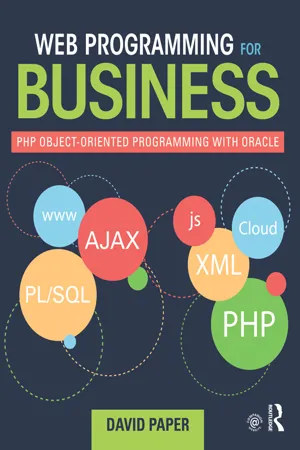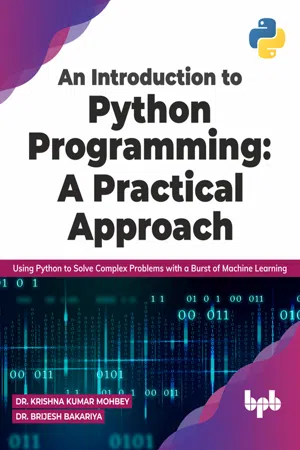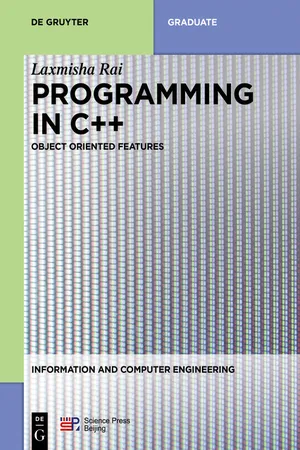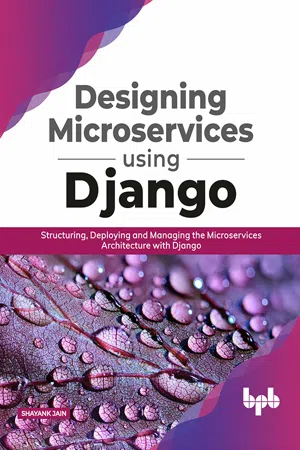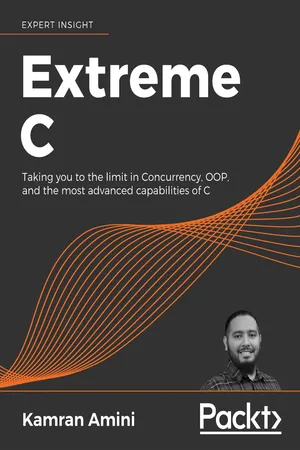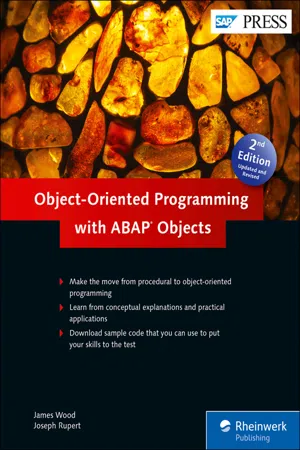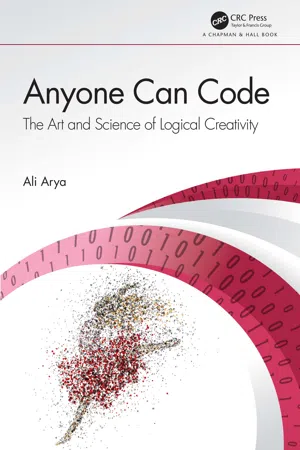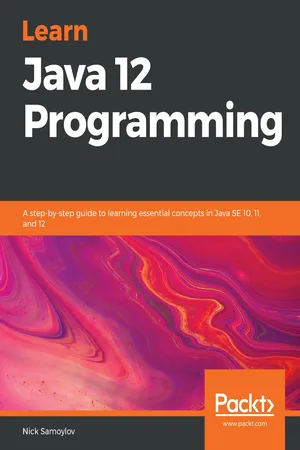Computer Science
Oops concepts
Oops concepts, short for Object-Oriented Programming (OOP) concepts, are fundamental principles used in software development. They include concepts such as inheritance, encapsulation, polymorphism, and abstraction, which enable the creation of modular, reusable, and maintainable code. OOP promotes the organization of code into objects, each with its own data and behavior, leading to more efficient and scalable software development.
Written by Perlego with AI-assistance
Related key terms
11 Key excerpts on "Oops concepts"
- eBook - ePub
Web Programming for Business
PHP Object-Oriented Programming with Oracle
- David Paper(Author)
- 2015(Publication Date)
- Routledge(Publisher)
2 Object-Oriented Concepts and Fundamentals DOI: 10.4324/9780203582084-2Overview
Object-oriented programming (OOP) is a design philosophy that uses objects and methods rather than linear concepts of procedures and tasks (procedural programming) to accomplish programmatic goals. An object is a self-sustainable construct that enables reusability of code. A method specifies one operation without providing any details to describe how the operation should be carried out. This chapter covers OOP fundamentals, including classes, properties, methods, and objects. In addition, encapsulation, polymorphism, inheritance, abstract classes, interfaces, aggregation, and supplemental OOP concepts are covered.Learning Objectives
After you complete this chapter, you will gain a fundamental understanding of OOP concepts through explanation and code examples. The following objectives summarize the skills the chapter will help you develop:- Learn the main advantages of OOP.
- Learn the building blocks of OOP.
- Learn how to create and instantiate a class.
- Learn OOP fundamentals.
- Learn about getters and setters.
- Learn about the constructor, destructor, and ‘toString’ methods.
- Learn about constants and static methods and properties.
- Learn about type hinting.
- Learn about exception handling.
- Learn about debugging.
Advantages of OOP
Object-oriented programming (OOP) has four main advantages over procedural programming – modularity, code reusability, information-hiding, and debugging ease.Modularity is when a piece of code is independent of other pieces of code. Reusability is when code can be used, without modification, to perform a specific service regardless of what application uses the code. OOP facilitates code reusability by making it easy to break down complex tasks into generic modules (classes) and separate files that contain classes from the main PHP script. Information-hiding is when the details of the internal implementation of a module (class) remain hidden from the outside world. Debugging ease - eBook - ePub
IT Interview Guide for Freshers
Crack your IT interview with confidence
- Sameer S Paradkar(Author)
- 2019(Publication Date)
- BPB Publications(Publisher)
C HAPTER 6 Object-oriented Programming (OOPs) O bject-oriented programming also known as OOP is a paradigm which is usually cantered around the concept of classes and objects and which includes data, known as attributes; and functions, known as methods. In the OOP paradigm, the object's methods can access and change the data fields. In the OOP paradigm, applications are designed by creating objects that interact with each other. There is usually a considerable variety of OOP languages, but many widespread ones are structured around the class, that is, objects are instances of classes, which also govern their type. This chapter covers the OOPs aspects and provides the question bank which includes topics for core concepts, encapsulation, composition and inheritance, and polymorphism. Concepts What is object-oriented programming (OOPs)? What are classes and objects? Object-oriented programming (OOPs) is a model to create logical modules known as classes consisting of properties, fields, methods, and events. An object is usually created by the program from a class definition. This object encapsulates the features such as behavior and data. OOP facilitates developing modular applications and assembles them as software programs. Class: A class explains the attributes and functions that define the behavior. A class is a template for an object. A class is a complete data type, which represents a template for the objects. A class is the fundamental building block of the OOPs application. This is usually a template that defines the properties, behaviors, events for a particular group of objects. The class consists of behavior and data. For example, the aircraft class contains data such as category, model number, color, and behavior such as length of the flight time, speed, and total number of passengers - eBook - ePub
An Introduction to Python Programming: A Practical Approach
step-by-step approach to Python programming with machine learning fundamental and theoretical principles.
- Dr. Krishna Kumar Mohbey; Dr. Brijesh Bakariya(Author)
- 2021(Publication Date)
- BPB Publications(Publisher)
Python, like other general-purpose programming languages, has been an object-oriented language. It enables us to build applications in an object-oriented manner. We can easily develop and use classes and objects in Python. Using classes and objects to construct the software is an object-oriented paradigm. The object is linked to real-world objects such as a computer, a home, a mobile, etc. The OOPS definition emphasizes the development of reusable code. It is a common method of resolving a problem by creating objects. The following are the key concepts of an object-oriented programming paradigm:- Class
- Object
- Method
- Data Abstraction and Encapsulation
- Inheritance
- Polymorphism
Introduction to classes
A set of objects can be described as a class. It's a logical entity with some unique properties and methods. For instance, if you have a student class, it should have an attribute and a method, such as name, age, address, and course.Object
The object is a self-contained entity with state and actions. It could be a laptop, a purse, a phone, a table, a pencil, or something else. In Python, everything is an object, with attributes and methods on almost everything. A class must construct an object to assign memory when it is defined.Method
In Python, a method is like a function, except that it is linked to objects and classes. Except for two big variations, Python methods and functions are similar.- For the object for which it is named, the method is used implicitly.
- Data in the class is accessible to the method.
Data abstraction and encapsulation
In object-oriented programming, encapsulation is also essential. It's used to limit access to variables and methods. Encapsulation protects code and data from accidental modification by wrapping them together in a single device.Abstraction is a technique for hiding internal information and displaying only the functionalities. The term abstract - eBook - ePub
Programming in C++
Object Oriented Features
- Laxmisha Rai, Laxmisha Rai(Authors)
- 2019(Publication Date)
- De Gruyter(Publisher)
classes . OOP concepts are different from other programming languages. All real-world objects are represented by objects. Every object has certain state and behavior. The state of the object is represented by variables and the behavior by methods. An object together with variables and related methods is a software entity. Moreover, an object is an instance of a class. The class is similar to a model or blueprint for creating objects. One class may have multiple instances of objects. For example, Wang is a student. Here, Wang is an object and student is a class.Modularity and information hiding
In OOP, the source code of an object can be written and maintained independently of the source code for other objects. This will greatly help us to use the object anywhere in the program. This property is called modularity . Also, an object has private and public interface. It will greatly help us to maintain the information and helps us to communicate with other objects.Inheritance
Object-oriented programming allows us to define classes from other classes, which is called inheritance . It plays a major role in writing large programs. Inheritance property is highly useful when we deal with many similar classes with minor changes. Inheritance enables us to define a new class based on an existing class definition. For example, if a book is a class then a notebook is a subclass . We will see that many characteristics of a notebook are derived from the book class, such as size, pages, and cover, etc. Here, we call the book class as a parent class (or super class or base class ) and the notebook class as a child class (or subclass or derived class ).Constructors
The constructors are one of the most powerful features of object-oriented languages. They are used for initializing objects during its creation. Initialization of data members is necessary when we deal with multiple objects of the same class. A constructor is a special method that is executed when the object of that class is created. The name of the constructor must be the same as that of the class name. - eBook - ePub
Designing Microservices using Django
Structuring, Deploying and Managing the Microservices Architecture with Django
- Shayank Jain(Author)
- 2020(Publication Date)
- BPB Publications(Publisher)
HAPTER 2Major Pillars of OOPS with Python
P ython is an object-oriented programming (OOP ) language. It also supports many features of OOPS. This chapter covers all OOP concepts, which are available in Python. We included this chapter in the book, because OOP is a very important part of every object-oriented language. In this chapter, we have tried to explain the OOP concept with the simplest terms and real-world examples.Structure
- Introduction to object-oriented programming (OOP) language
- Basic idea of object
- What is class?
- Decorators in Python
- Introduction of class method and static method in Python
- Inheritance
- Single inheritance
- Multiple inheritance
- Multilevel inheritance
- Encapsulation
- Polymorphism
- Method overloading
- Method overriding
- Abstraction
Objective
At the end of this chapter, you should easily understand the object, classes, class variables, static method, class methods, major pillars of OOPs, and decorators.Introduction to object-oriented programming (OOP) language
Earlier, while writing code programmers used to face the following difficulties:- Code duplication
- less security of the code
- code following the procedural programming
- Difficulty to manage long codes
- less readability of code due to lack of relevance to the real world
- Object
- Class
- Inheritance
- Encapsulation
- Polymorphism
- Abstraction
Basic idea of object
This is the very common definition of object, which is available on the internet: The object is a real-world entity, which has attributes and behavior. For example, a car is an object which has attributes such as color, brand, tiers, seats, speed, and more.What is class?
It is the collection of objects, functions, and statements. We can also say that it is a user-defined structure, which has collective data related to the class. For example, we have class Engineering_college - eBook - ePub
Extreme C
Taking you to the limit in Concurrency, OOP, and the most advanced capabilities of C
- Kamran Amini(Author)
- 2019(Publication Date)
- Packt Publishing(Publisher)
information-hiding , which is something of a side effect (though a very important one) of having encapsulation. Without information-hiding, we wouldn't be able to isolate and decouple software modules, and we'd effectively be unable to provide implementation-independent APIs to clients. This is the last thing we discuss as part of this chapter.As mentioned, the whole topic will cover four chapters, with the following chapters picking up from the composition relationship. From there, the upcoming chapters will cover aggregation , inheritance , polymorphism , abstraction .In this chapter, though, we'll start with the theory behind OOP and look at how we can extract an object model from our thought process regarding a software component.Object-oriented thinking
As we said in the chapter introduction, object-oriented thinking is the way in which we break down and analyze what surrounds us. When you're looking at a vase on a table, you're able to understand that the vase and the table are separate objects without any heavy analysis.Unconsciously, you are aware that there is a border between them that separates them. You know that you could change the color of the vase, and the color of the table would remain unchanged.These observations show us that we view our environment from an object-oriented perspective. In other words, we are just creating a reflection of the surrounding object-oriented reality in our minds. We also see this a lot in computer games, 3D modeling software, and engineering software, all of which can entail many objects interacting with each other.OOP is about bringing object-oriented thinking to software design and development. Object-oriented thinking is our default way of processing our surroundings, and that's why OOP has become the most commonly used paradigm for writing software. - eBook - ePub
- James Wood, Joseph Rupert(Authors)
- 2015(Publication Date)
- SAP PRESS(Publisher)
This chapter provides an overview of object-oriented programming from a conceptual point of view. The concepts described in this chapter lay the foundation for the remainder of the book.1 Introduction to Object-Oriented Programming
Object-oriented programming (OOP) is a programming paradigm in which developers approach program design by modeling solutions in terms of a series of objects that simulate real-world entities from the problem domain. This shift in design philosophy helps us achieve program designs which more closely resemble the world around them. As a result, object-oriented designs tend to be easier to understand, maintain, and extend. The purpose of this chapter is to introduce you to the basic concepts you’ll need to understand in order to effectively design and develop object-oriented programs. These concepts generally apply to most modern OOP languages such as C++, Java, and, of course, ABAP Objects. This chapter will also begin an introduction to the Unified Modeling Language (UML), which is the de facto object modeling language used in the software industry today.1.1 The Need for a Better Abstraction
In the field of software engineering, few topics incite more controversy than object-oriented programming. Loyalists defend the merits of OOP with near religious fervor, while detractors often roll their eyes at the very thought of it. If you’re reading this book, it’s likely that you find yourself somewhere in the middle of this seemingly endless debate. And if that’s the case, probably the most pressing questions on your mind include the following: - eBook - ePub
Anyone Can Code
The Art and Science of Logical Creativity
- Ali Arya(Author)
- 2020(Publication Date)
- Chapman and Hall/CRC(Publisher)
3 But most modern applications have two important features:3 Linus Torvalds, the creator of Linux Operating System, I quoted to say “limiting your project to C means that people don’t screw things up with any idiotic ‘object model’.”- They have different data items that can be grouped into separate entities with their own operations.
- They have a non-linear behavior that consists of entities interacting with each other at non-pre-defined times instead of a predefined flow of actions.
Organizing programs as a series of potentially interactive entities, each capable of performing operations, is the key advantage of OOP , which is made possible by encapsulation, the first property of Object-Oriented languages. Encapsulation provides multiple benefits to programmers:- More manageable programs as the related code and data are clearly grouped
- More reusable programs as the modules are more self-sufficient and easier to copy to another application (source code or compiled binary)
- Information hiding is better supported through defining objects and their interfaces4
- Interactive applications are easier to design with Object-Oriented Programs compared to procedure-oriented ones.
I will discuss and illustrate these advantages in this and the next section. OOP has two other basic properties called Inheritance and Polymorphism that I will introduce in Part 5.The starting point of any object-oriented program, which is the key to creating a manageable and reusable code, is to select and define the right classes. Recall the data-centered approach for designing programs that I introduced earlier in the book: - eBook - ePub
Java Professional Interview Guide
Learn About Java Interview Questions and Practise Answering About Concurrency, JDBC, Exception Handling, Spring, and Hibernate
- Mandar Maheshwar Jog(Author)
- 2021(Publication Date)
- BPB Publications(Publisher)
HAPTER 3Object Orientation
Introduction
Object-Oriented Programming (OOP) language is a paradigm that has changed the approach of the traditional programming language. Earlier developers were frustrated by writing boilerplate code and maintaining it. In this modern era, developers can leverage the advantages of OOP and create applications that are easily extensible and maintainable. If you are not well versed with object orientation, then you will certainly fail miserably while developing your applications.Structure
Learning OOP can be little bit boring. Object orientation principles are complex in nature theoretically as well as practically. There are many books available from which you can learn the OOP language. But, this chapter is focused on how you get successful in the questions asked about OOP. We will be covering the following concepts during this discussion:- Class and objects
- Abstraction
- Encapsulation
- Inheritance
Objective
At the end of this chapter, you will be able to understand the core features of the OOP language, how to implement different concepts of the OOP language in Java. Also, we will discuss many interview questions as this is one of the most important segment of your interview.Class and objects
The primary concept to understand about object orientation is a class and object. It is kind of "Evolution of Earth," which is then followed by the other living organism. So, one need to understand clearly about the class and object before proceeding to other concepts. Let us discuss what type of questions you will face and how to answer them.What is a class?
A class - eBook - ePub
Learn Java 12 Programming
A step-by-step guide to learning essential concepts in Java SE 10, 11, and 12
- Nick Samoylov(Author)
- 2019(Publication Date)
- Packt Publishing(Publisher)
implement an interface. Since an interface describes how you can interact with an object, but not how an object responds to the interaction, different objects can behave differently while implementing the same interface.In Java, a class can have only one direct parent but can implement many interfaces. The ability to behave as any of its ancestors and adhere to multiple interfaces is called polymorphism .In this chapter, we will look at these OOP concepts and how they are implemented in Java. The topics discussed include the following:- OOP concepts
- Class
- Interface
- Overloading, overriding, and hiding
- Final variable, method, and class
- Polymorphism in action
Passage contains an image
OOP concepts
As we have already stated in the introduction, the main OOP concepts are as follows:- Object/Class : It defines a state (data) and behavior (methods) and holds them together
- Inheritance : It propagates behavior down the chain of classes connected via parent-child relationships
- Abstraction/Interface : It describes how the object data and behavior can be accessed. It isolates (abstracts) an object's appearance from its implementations (behavior)
- Encapsulation : It hides the state and details of the implementation
- Polymorphism : It allows an object to assume an appearance of implemented interfaces and behave as any of the ancestor classes
Passage contains an image
Object/class
In principle, you can create a very powerful application with minimal usage of classes and objects. It became even easier to do this after functional programming was added to Java 8, to JDK, which allowed you to pass around behavior as a function. Yet passing data (state) still requires classes/objects. This means that the position of Java as an OOP language remains intact.A class defines the types of all internal object properties that hold the object state. A class also defines object behavior expressed by the code of the methods. It is possible to have a class/object without a state or without a behavior. Java also has a provision for making the behavior accessible statically—without creating an object. But these possibilities are no more than just additions to the object/class concept that was introduced for keeping the state and behavior together. - eBook - ePub
- Nick Samoylov(Author)
- 2022(Publication Date)
- Packt Publishing(Publisher)
examples/src/main/java/com/packt/learnjava/ch02_oop folder.OOP concepts
As we have already stated in the introduction, the main OOP concepts are as follows:- Class : This defines the properties and behavior (methods) of objects that are created based on this class.
- Object : This defines a state (data) as values of its properties, adds behavior (methods) taken from a class, and holds them together.
- Inheritance : This propagates behavior down the chain of classes connected via parent-child relationships.
- Interface : This describes how object data and behavior can be accessed. It isolates (abstracts) an object’s appearance from its implementations (behavior).
- Encapsulation : This hides the state and details of the implementation.
- Polymorphism : This allows an object to assume an appearance of implemented interfaces and behave like any of the ancestor classes.
Object/class
In principle, you can create a very powerful application with minimal usage of classes and objects. It became even easier to do this after functional programming was added to Java 8, to a JDK, which allowed you to pass around behavior as a function. Yet passing data (state) still requires classes/objects. This means that the position of Java as an OOP language remains intact.A class defines the types of all internal object properties that hold the object state. A class also defines object behavior expressed by the code of the methods. It is possible to have a class/object without a state or behavior. Java also has a provision for making the behavior accessible statically – without creating an object. But these possibilities are no more than just additions to the object/class concept that was introduced for keeping the state and behavior together.
Index pages curate the most relevant extracts from our library of academic textbooks. They’ve been created using an in-house natural language model (NLM), each adding context and meaning to key research topics.
